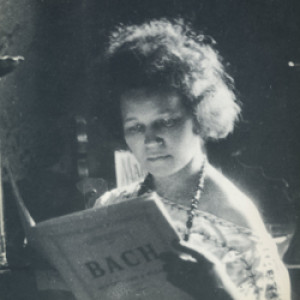Antonietta Raphael facts for kids
Quick facts for kids
Antonietta Raphaël
|
|
|---|---|

Antonietta Raphaël in 1918
|
|
| Born |
Antonietta Raphaël de Simon
1895 |
| Died | 5 September 1975 |
| Nationality | Italian |
| Education | Expressionism |
| Known for | Painting, Sculpture |
|
Notable work
|
Adolescente (Adolescent, 1928) Simona in fasce (1928) |
| Movement | Scuola romana |
| Patron(s) | Mario Mafai (husband) Alberto Della Ragione |
Antonietta Raphaël (1895 – 5 September 1975) was an Italian sculptor and painter. She was born in Lithuania and had Jewish heritage. Antonietta Raphaël helped start the Scuola Romana (Roman School) art movement with her husband, Mario Mafai.
She was an artist who did not like traditional art rules. Her sculptures, especially after World War II, became very important. They showed a soft and lively feeling in stone, with famous works like Miriam dormiente (Sleeping Miriam) and Nemesis.
Antonietta Raphaël's Life
Antonietta Raphaël was the daughter of a rabbi (a Jewish religious leader). After her father passed away, she and her mother moved to London. There, she visited the British Museum often. She also met famous artists like Jacob Epstein and Ossip Zadkine, who was a French sculptor known for Expressionism.
At this time, Antonietta focused on music. She studied piano at the Royal Academy of Music. She also taught solfeggio (music reading) in the East End of London.
After her mother died in 1919, Antonietta moved to Paris. In 1924, she moved to Rome, Italy. In 1925, she attended the Accademia di Belle Arti (Academy of Fine Arts). She became friends with artist Mario Mafai and they lived together for many years. They had three daughters:
- Miriam (born 1926) became a journalist.
- Simona (born 1928) became a member of the Italian Parliament and an author.
- Giulia (born 1930) worked as a set and costume designer for plays and movies.
Her Art Career
In 1927, Antonietta Raphaël and Mario Mafai moved to an apartment in Via Cavour in Rome. Their home quickly became a popular meeting place for writers like Giuseppe Ungaretti and Leonardo Sinisgalli. Young artists such as Scipione and Corrado Cagli also gathered there. This is how the Scuola Romana (Roman School) art movement began.
In 1929, Raphaël showed her art for the first time at an exhibition called I Sindacale in Lazio. She was supported by art historian Roberto Longhi. In 1930, she and Mafai went to Paris. There, she started to focus more on sculpture instead of painting.
In 1932, she visited London and met Jacob Epstein again. She then moved back to Rome for good. She began working on a major sculpture called Fuga da Sodoma (Escape from Sodom). She worked on it for a year in the studio of sculptor Ettore Colla. Between 1936 and 1938, she showed her work at more Sindacali exhibitions.
During this time, her sculptures had a unique style. They were not like other Italian sculptures of that period. Instead, they showed influences from artists like Emile-Antoine Bourdelle. Because of the racial laws put in place by the government, which made it dangerous for Jewish people, Raphaël had to escape to Genoa with her husband and daughters. They were helped and kept safe by art collector Emilio Jesi and a kind person named Alberto Della Ragione.
During World War II (from 1943 to 1945), Raphaël stayed in Rome with her daughter Giulia. Later, she moved to Genoa again to work with a group of older sculptors.
In 1948, Raphaël showed her art at the Biennale di Venezia, a very important art exhibition. This was after a difficult time when money was tight. From 1952, art critics began to truly appreciate her work. Some of her pieces were shown at the Galleria dello Zodiaco in Rome.
In 1956, she traveled to China. She exhibited her artwork in Beijing alongside other artists like Aligi Sassu. She continued to have exhibitions in Europe, Asia, and the Americas. At the 8th Rome Quadriennale in 1959-1960, which focused on the Scuola Romana, many of her works were displayed. This showed that she was one of the most important artists of this school. By this point, Raphaël was mostly creating sculptures and had stopped painting.
What Critics Thought
Antonietta Raphaël had a very free and open personality. She had also experienced many different cultures. This brought a unique, international feeling to the art scene in Rome.
During the years of the Scuola di Via Cavour, she created portraits and landscapes. These works had simple shapes and sometimes unusual forms. They mixed a simple, "naïve" style with dream-like fantasy, similar to the artist Marc Chagall. From 1932, her sculptures became very strong and natural-looking. They also had symbolic and grand meanings, reminding people of art from Eastern cultures.
Filmography
- Io non sono un altro - l'arte di Mario Mafai (I Am Not the Other - The Art of Mario Mafai), DVD, Studio Angeletti & Scuola Romana Archive, 2005, directed by Giorgio Cappozzo

